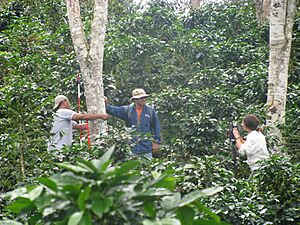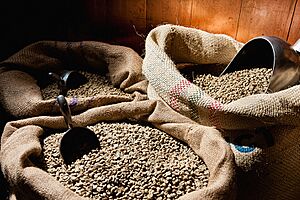Coffee production in Peru facts for kids
Peru is a big player in the world of coffee. In 2014, it was one of the top 20 countries that produce coffee. It's also one of the top five countries that export a special type of coffee called Arabica coffee around the globe.
Contents
History of Peruvian Coffee
Peru has been known for growing coffee for a long time. Back in 1895, a report mentioned this fact. At first, most coffee grown near the coast was for people in Peru to drink. Later, Peru started sending its coffee to other countries.
Coffee plants were first grown near the port of Pacasmayo. People still grow coffee there today. Coffee also grew in the south, in areas like Sandia. In central Peru, coffee farms started in valleys like Chanchamayu and Huánuco. It became easier to grow coffee in Chanchamayo when the Oroya Railway was finished. This train line helped move coffee.
The Chanchamayo Valley is about 10 miles long. It had many private coffee farms. Other valleys like Perené were later connected by railway. Peru started exporting coffee to Germany and England in 1887.
In the 1970s, big factories for processing coffee were built near ports. This made it easy to ship large amounts of coffee. The focus was on quantity, not always on the best quality. Today, things have changed. The government is helping farmers use modern methods. They also encourage groups like CENFROCAFE to work together.
Coffee Cooperatives
CENFROCAFE is a special group called a cooperative. It helps over 80 groups of farmers. It also has six places where coffee beans are processed. This cooperative helps farmers sell their coffee directly to buyers around the world. This means more money goes to the hundreds of coffee growers in the region.
All the coffee sold by these groups grows high up in the mountains, above 1,000 meters. CENFROCAFE has helped many farm families reach international markets. About 92% of the coffee they sell is organic. This means it's grown without harmful chemicals. Also, 100% of their coffee is certified as Fair Trade. This means farmers get a fair price for their hard work.
This system has made Peruvian coffee better quality. It has also created more demand for it globally. Most coffee in Peru is processed right on the farms. This is called "wet milling." It reduces the moisture in the coffee beans. Then, the beans are sent to bigger factories. However, this method can sometimes lead to problems. It can cause quality issues or even fungus growth in some areas.
Coffee Production in Peru
The main places where coffee is grown in Peru are on the eastern side of the Andes mountains. These areas include Chanchamayo, the Amazonas region, and San Martin. There are also farms in the southern highlands. St Ignacio, near the border with Ecuador, is a key coffee growing area in northern Peru.
Most of the coffee grown is Arabica. About 70% of this is a type called Typica. Another 20% is caturra, and the rest are other kinds. About 75% of coffee farms are located between 1,000 and 1,800 meters high. Farmers often plant coffee trees in shaded areas. They can plant up to 2,000 plants in one hectare (about 2.5 acres).
Small farmers do most of the coffee growing. They pick the coffee by hand. About 90,000 hectares of land are used to grow organic coffee.
In 1893, Peru produced about 1,500 tons of coffee. By 2013, this had grown to 256,241 tons. This came from an area of almost 400,000 hectares.
Most of the coffee grown in Peru is sent to other countries. In 2012, Peru exported over 264,000 tons. The main buyers were the US, Germany, and Belgium. Only about 10% of the coffee was used in Peru. In 2014, a plant disease called "coffee rust" affected many farms. This caused coffee production to drop by 6% compared to 2013.
Coffee Consumption in Peru
Even though Peru produces a lot of coffee, people in Peru don't drink much of it. Over 200,000 people in Peru depend on coffee farming for their living. But each person only drinks about 600-800 grams of coffee per year.
The market for roasted and instant coffee in Peru is worth about 110 million US dollars. In 2018, the amount of coffee bought by households grew by 3.4%. In 2020, it grew by 6%. This shows that more young people are starting to drink quality coffee. In 2018, the value of ground coffee sales went up by 26%. People also bought it more often, about 30 times a year. Instant coffee is still the most popular type.
Besides big brands like Altomayo, Nescafe, and Starbucks, smaller coffee shops are becoming popular. Starbucks has over 100 shops in Peru. But many "independent" specialty coffee shops are opening. These shops often sell coffee from a single farm or region. Some popular independent shops include Origen Tostadores de Cafe and PukuPuku. These places are helping more Peruvians enjoy different kinds of coffee.
See also
 In Spanish: Café de Perú para niños
In Spanish: Café de Perú para niños



